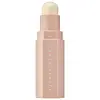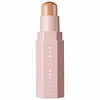What's inside
What's inside
 Key Ingredients
Key Ingredients

 Benefits
Benefits

 Concerns
Concerns

 Ingredients Side-by-side
Ingredients Side-by-side

Ethyl Oleate
EmollientOctyldodecanol
EmollientEthyl Stearate
EmollientPhenyl Trimethicone
Skin ConditioningSimmondsia Chinensis Seed Oil
EmollientDibutyl Lauroyl Glutamide
Skin ConditioningButyrospermum Parkii Butter Unsaponifiables
Skin ConditioningEthyl Linoleate
EmollientDibutyl Ethylhexanoyl Glutamide
Skin ConditioningEthyl Palmitate
EmollientAroma
Mica
Cosmetic ColorantSilica
AbrasiveSqualene
EmollientMedicago Sativa Extract
TonicCocos Nucifera Oil
MaskingCitric Acid
BufferingCI 77891
Cosmetic ColorantEthyl Oleate, Octyldodecanol, Ethyl Stearate, Phenyl Trimethicone, Simmondsia Chinensis Seed Oil, Dibutyl Lauroyl Glutamide, Butyrospermum Parkii Butter Unsaponifiables, Ethyl Linoleate, Dibutyl Ethylhexanoyl Glutamide, Ethyl Palmitate, Aroma, Mica, Silica, Squalene, Medicago Sativa Extract, Cocos Nucifera Oil, Citric Acid, CI 77891
Tricaprylin
MaskingC12-15 Alkyl Ethylhexanoate
EmollientSynthetic Wax
AbrasivePolymethyl Methacrylate
Octyldodecanol
EmollientMica
Cosmetic ColorantOctyldodecyl Neopentanoate
EmollientSucrose Acetate Isobutyrate
Cera Microcristallina
Emulsion StabilisingSilica
AbrasivePolymethylsilsesquioxane
Vp/Eicosene Copolymer
Vp/Hexadecene Copolymer
Cetyl PEG/PPG-10/1 Dimethicone
EmulsifyingCaprylyl Glycol
EmollientPentaerythrityl Tetra-Di-T-Butyl Hydroxyhydrocinnamate
AntioxidantTocopheryl Acetate
AntioxidantAscorbyl Palmitate
AntioxidantCocos Nucifera Oil
MaskingTocopherol
AntioxidantCalcium Sodium Borosilicate
Synthetic Fluorphlogopite
Calcium Aluminum Borosilicate
Polyethylene Terephthalate
Acrylates Copolymer
Sodium Hyaluronate
HumectantBHT
AntioxidantTin Oxide
AbrasiveIron Oxides
CI 77891
Cosmetic ColorantTricaprylin, C12-15 Alkyl Ethylhexanoate, Synthetic Wax, Polymethyl Methacrylate, Octyldodecanol, Mica, Octyldodecyl Neopentanoate, Sucrose Acetate Isobutyrate, Cera Microcristallina, Silica, Polymethylsilsesquioxane, Vp/Eicosene Copolymer, Vp/Hexadecene Copolymer, Cetyl PEG/PPG-10/1 Dimethicone, Caprylyl Glycol, Pentaerythrityl Tetra-Di-T-Butyl Hydroxyhydrocinnamate, Tocopheryl Acetate, Ascorbyl Palmitate, Cocos Nucifera Oil, Tocopherol, Calcium Sodium Borosilicate, Synthetic Fluorphlogopite, Calcium Aluminum Borosilicate, Polyethylene Terephthalate, Acrylates Copolymer, Sodium Hyaluronate, BHT, Tin Oxide, Iron Oxides, CI 77891
Ingredients Explained
These ingredients are found in both products.
Ingredients higher up in an ingredient list are typically present in a larger amount.
Ci 77891 is a white pigment from Titanium dioxide. It is naturally found in minerals such as rutile and ilmenite.
It's main function is to add a white color to cosmetics. It can also be mixed with other colors to create different shades.
Ci 77891 is commonly found in sunscreens due to its ability to block UV rays.
Learn more about CI 77891Cocos Nucifera Oil is obtained from the kernels of the coconut fruit. In other words, this is coconut oil.
Coconut Oil is rich in fatty acids with lauric acid making up the majority of these. It also contains linoleic acid. Due to this high fatty acid content, coconut oil helps trap moisture and soften skin.
Despite being antibacterial, coconut oil may not be great for acne-prone skin. It is comedogenic and may clog pores. This ingredient may not be safe for malassezia or fungal acne.
Note: Coconut Oil should not replace your sunscreen for UV protection. Studies show it only blocks about 20% of UV.
This oil is non-volatile and has a light scent.
The term 'fragrance' is not regulated in many countries. In many cases, it is up to the brand to define this term. For instance, many brands choose to label themselves as "fragrance-free" because they are not using synthetic fragrances. However, their products may still contain ingredients such as essential oils that are considered a fragrance.
Learn more about Cocos Nucifera OilMica is a naturally occurring mineral used to add shimmer and color in cosmetics. It can also help improve the texture of a product or give it an opaque, white/silver color.
Serecite is the name for very fine but ragged grains of mica.
This ingredient is often coated with metal oxides like titanium dioxide. Trace amounts of heavy metals may be found in mica, but these metals are not harmful in our personal products.
Mica has been used since prehistoric times throughout the world. Ancient Egyptian, Indian, Greek, Roman, Aztec, and Chinese civilizations have used mica.
Learn more about MicaOctyldodecanol is a fatty alcohol. It is primarily used to enhance the texture of products.
As an emulsifier, Octyldodecanol helps prevent the oils and waters from separating. It also prevents ingredients from creating foam when shaken.
Octyldodecanol is created by reducing fatty acid to an alcohol.
Due to its high molecular weight, it does not get absorbed into the skin.
Learn more about OctyldodecanolSilica, also known as silicon dioxide, is a naturally occurring mineral. It is used as a fine, spherical, and porous powder in cosmetics.
Though it has exfoliant properties, the function of silica varies depending on the product.
The unique structure of silica enhances the spreadability and adds smoothness, making it a great texture enhancer.
It is also used as an active carrier, emulsifier, and mattifier due to its ability to absorb excess oil.
In some products, tiny microneedles called spicules are made from silica or hydrolyzed sponge. When you rub them in, they lightly polish away dead skin layers and enhance the penetration of active ingredients.
Learn more about Silica